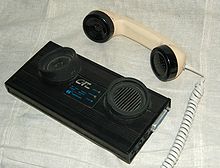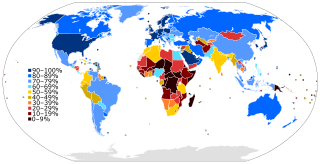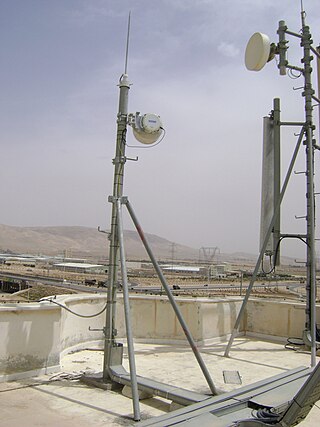History
Initial attempts and Cybersyn
Before the introduction of the internet in Chile, the country communicated abroad via Letters, the Correos de Chile service had been started by Chile in 1747 (when it was still part of the Spanish crown) [4] it was not until 1851 that a telegraphy service began for communication with the outside world, initially in 1851 wired and officially wireless since 1904 [5] (with a certain role being played by the Vía Trans Radio Chilena Compañía de Radiotelegrafía, which would become later in VTR), later communication with the outside arose via Telephone -whose implementation had begun in Valparaíso in 1878 by Compañía Chilena de Telefonos de Edison -which in 1930 would become the Compañía Telefónica de Chile-
Perhaps the closest previous experience to the contemporary internet was the development of Cybersyn, in 1970 the world was experiencing the Cold War and Chile was led by a government that sought to establish a socialist state , After nationalizing and annexing various socially owned companies to the State, the Allende government's economic system faced the need to coordinate information on existing state-owned companies and those recently nationalized. To achieve this, it was necessary to create a dynamic and flexible information transfer system, a task carried out by a British scientist the architect of systems Stafford Beer. [6]

Since there were 500 unused teletypes, all of them acquired during the government of Eduardo Frei Montalva, each one of the machines was installed in an expropriated factory. At the control center in Santiago, a computer daily processed the information received from the factories. By processing such information, short-term predictions and recommendations for improvements were obtained. There were four levels of control (company, branch, sector and total) that had algedonic feedback (if the lower level of control could not solve a problem in a given time interval, the higher level was notified about it). The results were discussed in the operating room and an overall plan was drawn up. [7]
The network was built between November 1971 and the same month of 1972, although it was never fully completed. The system was used experimentally in October 1972, during the October 1972 strike, when 50 000 unemployed truckers blocked the streets of Santiago. Using teletype machines, the government was able to coordinate the transport of food to the city with the approximately 200 trucks loyal to Allende and who were not unemployed. [8]
With the 1973 Chilean coup d'état, the control center was destroyed, documents and existing telephone and teletype infrastructure were destroyed, Cybersyn could never be applied and was irrevocably aborted, additionally with the change of Cold War bloc by the Government Junta of Chile (1973) – which advocated a free market- a network that running a Self-managed economy made no sense.
The university network

The Internet in Chile -as we know it- dates back to the ARPANET project, in 1972 the universities of the United States copied the ARPANET model and implemented it to exchange opinions among themselves and support themselves in their academic research, however, This development was not copied in Chile, only in 1986, from the Department of Computer Science of the University of Chile to the Department of Computer Engineering of the University of Santiago de Chile, through a UUCP platform, some tests were carried out. and mailings between said universities using 300-bit modems and the CTC telephone line (which at that time had national coverage), imitating a sort of Intranet model. [9]
It was not until 1987 when Dr. Florencio Utreras (of the Universidad de Chile) connected the country with BITNET, which was an academic network of the City University of New York and Yale University, giving rise to the Internet. in Chile. [10]
Subsequently, the University of Santiago abandoned the collaboration and joined the Pontificia Universidad Católica (PUC). [11] In its beginnings, the Internet worked between local universities and with some universities abroad using modems and pre-existing telephone lines of the only telephone company in Chile -which had a monopoly-. The domain .cl was given in 1986 to the Department of Computer Sciences (DCC) of the University of Chile and later began to be managed by NIC Chile, beginning to be commercialized only in the year 1997. [12]
The commercialization of 56k and ADSL

Only in 1993 did the commercialization of the Internet begin in Chile, the then CTC (Compañía de Telefonos de Chile) acquired the technology from the University of Chile, while the technology from the Catholic University of Chile passed by various private owners until today it became Claro Chile. [13]
The then CTC (Compañía de Telefonos de Chile) using its existing telephone network, launched in 1993 the service of Dial-up Internet access -with maximum speeds of 56 Kilobit per second-, which had some peculiarities, it was not possible to use the telephone line and navigate at the same time, there was no local connection, so traffic between users of both networks had to navigate to US and return and the service was billed per second of access and as international long distance, which made the service exclusive to a large part of the population. [14]
Additionally, the majority of the population did not see the Internet as very useful, outside of the academic environment, there was no interest in the Internet in Chilean society. [15]
During the 1990s, telephone companies and long-distance carriers began to offer Internet connection services to the mass public.
The massiveness of the Internet in Chile began in 1997 and is essentially due to the creation of NAP Chile and a decree of the Chilean Government, which changed the form of Internet billing, which allowed between 1998 and 1999 to increase both Internet users, which tripled; as well as the number of minutes they used per month. [16]

In 1997 several Chilean ISPs associated to form a local traffic exchange point, called NAP Chile, which allowed us to improve both the traffic latency and the costs of its associated ISPs. [17]
In May 1999, the Chilean government decreed a change in the rates for those who access the Internet using telephone connections, a charging formula called "Local Tranche" would be used. The impact on the cost of use is direct for users, having a 62% decrease compared to the previous year. [18]
One of the main access barriers that the Internet service had in Chile was its charge per second of connection, it was towards the beginning of the year 2000, when Entel Chile and Telefónica Chile began to incorporate in their Existing telephone networks technology ADSL, fixed charge connections but at private prices for a large part of the population, with this Broadband was born, being able to have high speed was radically changing the impact of the Internet and its possible uses. [19]
The development of the HFC network and 3G

Around 1996, almost all of the internet in Chile was by Dial-up Internet access, however, a cable television company -Metrópolis (Chile)- on 17 October 1996, put into operation an interactive video game channel called Sega Channel, which allowed the download of content by the company Sega, this being the first Internet experience on the infrastructure of cable television, in 1999, VTR (Chile) launched Internet commercialization under its existing cable television network via the DOCSIS 1.0 standard and under independent connections of the telephone network, at high speed and with differentiated payments not for the amount of time used, conditions that do not offered the Dial-up Internet access., [20] and that today are the norm for all home internet providers. [21]
However, the infrastructure and access to the Internet via cable modem, was rather modest in its early years, it was only after 2004 when Internet access via Hybrid fiber-coaxial began to become widespread, granting with a commercial strategy of VTR the launch of its best-known promotion: the Triple Pack -which lowered the cost of contracting telephony, television and internet as a whole- and the merger of VTR with Metrópolis Intercom S.A. [22]
In 2002, the first third-generation networks began to be implemented thanks to the different agreements made abroad by SmartCom and Bellsouth, which allowed them to sell 1xRTT equipment capable of browsing at 150 kbit/s, with which the debut of the Mobile broadband, which would only begin to spread in the 2010s, with the increase in the issuance of a contract (postpaid), to the detriment of communication through recharges (prepaid), in 2013 the 4G and in 2022, 5G. [23]
The development of the FTTH and satellite network

The development of the Internet in Chile until 2006, was based on the conversion and reuse of two previously existing technologies in Chile, on the one hand, the Telephone line of the Compañía de Telefonos de Chile -which in some sectors it dated back to 1880–, via Digital subscriber line technology and on the other hand the cable television network of VTR -which in some sectors dating back to 1987–, via Hybrid fiber-coaxial technology, both had wide coverage in the national territory, but also had important technical limitations -especially the Telephone line- in terms of speed, latency and state of the cabling (causing the rapid decline of xDSL networks from 2015 to the present). [25]

Although internet providers via cable television infrastructure began to incorporate new DOCSIS standards and internet providers via Telephone line infrastructure progressively implemented ADSL2 and VDSL2, it was not until 2006 that the company Gtd began the deployment of a new infrastructure to provide internet, based on fiber to the home, initially, the infrastructure was deployed in sectors residential upper class and with limited geographical coverage, later in 2012 Movistar began the deployment of its new infrastructure of fiber to the home -with special massiveness of deployment since 2020–, to which Mundo and Entel joined in 2020, WOM in 2019 and VTR in 2021, these last three, with limited geographical coverage. [26]
Residential Satellite Internet in Chile is a rather limited phenomenon, most of its consumers are part of the economic development of the Rural area, the domestic Rural area uses mostly Mobile broadband, since 2014, Movistar markets Satellite Broadband, [27] to which would be added the following year Claro Chile, [28] in 2020 Hughes Communications would begin its commercialization, to which would be added the following year Starlink. [29] As of December 2021, it reported more than 1,500 clients. [30]
Contemporary Internet

Since 1999, the Government of Chile has incorporated a successive process of digitalization of its services. In 1999, the Servicio de Impuestos Internos, the government entity in charge of collecting taxes, received almost 90,000 declarations of income through the Internet, of the million total income statements for that year., [31] since the 2010s, a significant number of government procedures have been digitized, in addition to a progressive adoption of the Online banking and Electronic Commerce, coinciding with an accelerated globalization process in Chile from the years 2000. [32]
Analysts point out that a huge percentage of Chilean GDP has grown thanks to the Internet. Mining, agriculture and all traditional companies have been affected by their growth thanks to the Internet. The Internet has freed Chile from its isolated geography and has allowed Chile to insert itself into the world efficiently. [33]
The main internet infrastructure test Chile has experienced was the 2010 Chile Earthquake, which left a massive internet outage and much network infrastructure destroyed -Including a flood of Global Crossing servers- [34]
However, the main agent of change of the Contemporary Internet in Chile was the COVID-19 Pandemic, which caused an increase in Internet consumption in Chile that was reflected in the first months of the pandemic, where it was reported that the use of social networks increased by 53% compared to the same month of the previous year, above several other countries in the region. [35]

Data consumption per user reached 335.5 GB on fixed internet in April 2020, 29.4% more than the previous year. Regarding mobile internet consumption, it increased 26% to 13 Gigabytes in the same period, a situation even more accentuated with the COVID-19 lockdowns, where the network was exposed to intensive use, forcing operators to strengthen their existing infrastructure and society and the Government of Chile to digitize many of its benefits, emerging massively Teleworking, Telemedicine, Distance Education, Online banking absolutely, the Judiciary of Chile remotely, the Streaming and other services that are maintained to date. [36]
For the 2024 Chile wildfires in the Valparaíso region, due to the fire, telephone antennas were destroyed, as well as satellite backup systems and several kilometers of trunk and domestic fiber cabling, which added to the power outage widespread due to damage from fires and an unprecedented overload of the fixed and mobile network [37] caused that around 7 p.m. on February 2, 2023, all of Viña del Mar and Quilpué experienced a "blackout" of fixed and mobile internet from all companies, leaving IP Telephony and Transbank out of service (and with this out of service the processing of payment transactions with credit cards, debit banking and prepaid), although internet companies quickly activated National Emergency Automatic Roaming (RAN) (which is essentially automatically sharing their antennas, making communication redundant in case of failure at some point) and portable satellite teleports for the use of Chilean Armed Forces, Carabineros de Chile, Investigations Police of Chile, Firefighters of Chile and the emergency health services, domestic connectivity took several weeks to return to normal. integrity. [38]











